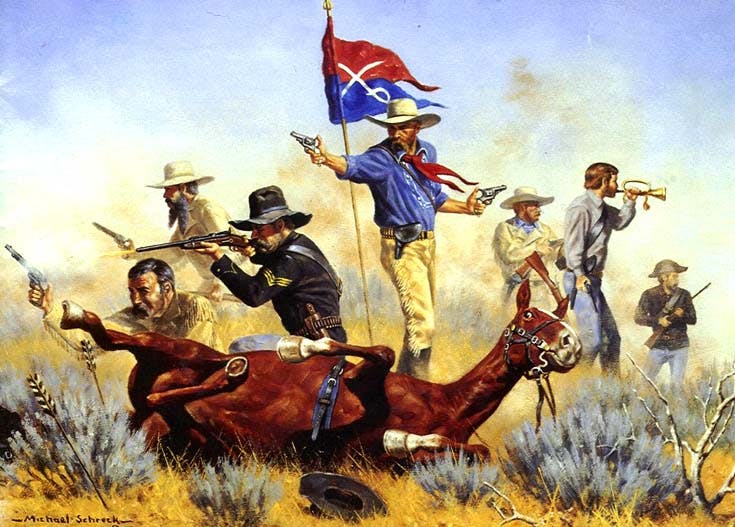Once upon a time, I made the case we should celebrate June 25 as “Bad Management Day,” a day when we reflect on all the terrible management decisions made by the many overpaid egomaniacs who wouldn’t know what management was if it walked up and bit ’em
Why June 25?
It’s because June 25, 2016 is the 140th anniversary of one of the worst management decisions of all time.
On June 25, 1876, Lt. Col. George Armstrong Custer made a fateful management decision to split his forces and engage an overwhelmingly superior force of more than 2,500 Lakota Sioux, Cheyenne and Arapaho warriors with only about 210 members of the 7th U.S. Cavalry along the Little Bighorn River in what is now southeastern Montana.
Custer’s five bad decisions
History is made of such decisions, and so it was for Custer, who paid dearly for his. He paid with his life — and the lives of two of his brothers, a nephew, a brother-in-law, and all those under his command — in an engagement long remembered as the Battle of the Little Bighorn, or “Custer’s Last Stand.”
Giving your life is the ultimate price for a bad decision, but Custer’s decision-making was especially poor in a number of different ways.

- He refused to listen to others, believing that his judgment was superior. Custer was ordered to hold off on any attack and to wait for reinforcements that were being led by Brig. Gen. Alfred Terry, but impatience got the better of him and Custer foolishly decided to act. Waiting would have been more sensible, because Gen. Terry and his troops arrived two days later, on June 27.
- He was arrogant. Custer was guilty of being overconfident in his own abilities, and guilty of hubris, just like so many modern executives. He grossly underestimated the number of Indians facing him, pooh-poohed their abilities, and failed to consider the many advantages his opponent had. Here’s a big one: While Custer’s troops were generally armed with single-shot rifles, the Indians had a number of repeating rifles that made their superior numbers even more so. Less hubris and ego might have helped Custer have a healthier respect of what he was facing.
- He wasn’t entirely focused on the job at hand. Custer’s focus wasn’t on fighting and defeating the Indians who were itching to fight him at the Little Bighorn. His misguided concern was that he needed to trap them and prevent their escape. That’s why he split his forces into three parts, diluting his overall strength. The other two units of the 7th Cavalry, led by Capt. Frederick Benteen and Maj. Marcus Reno, survived a fierce two-day fight that ended when Gen. Terry and his reinforcements arrived.
- He was outmaneuvered by an opponent who executed a perfect strategy. Custer was facing wily Indian leader Sitting Bull, who lured him into a fight on his timetable, on a field of his choosing, and with a much larger (and superior) force. In addition, Sitting Bull delegated well. He trusted in Crazy Horse, his able field lieutenant, who executed his battle plan perfectly.
- He had terribly bad luck. It’s often said that luck is when preparation and opportunity meet, and that was certainly true for Sitting Bull and his forces at the Battle of the Little Bighorn. The other side of that coin is that Custer had the terrible misfortune of deciding to attack what is still considered to be the single largest force of Native American warriors ever assembled on the North American continent, and he did it with an undersized and outgunned cavalry unit that he split into three parts.
A management formula: More patience, less hubris
On top of that, the Indian forces were passionate about what they were doing. They were defending their turf and felt they had something to prove. Custer’s cavalry, on the other hand, was tired of chasing Indians around the northern Plains and just wanted to get home. They had very little passion for fighting at all.
Add all of that up and what you get is not just bad decision-making by Custer, but also terribly poor luck as well.
So it goes for bad managers, it seems.
Change just a few of these elements, and perhaps invest Custer with less hubris and more patience, and maybe he would have never fought the Battle of the Little Bighorn and lived to fight another day. Who knows? But, history would likely be very different if any of that happened.
These are all good things to consider on Bad Management Day. Had George Armstrong Custer thought like a manager and made better decisions, and had he not been driven so completely by his oversized ego, he might have survived and perhaps eventually run for president as many expected.
And one more thing: Sometimes, there’s a fine line between winning and losing, between success and failure (or in Custer’s case, total disaster). Keep that in mind as you reflect on Bad Management Day.
Want more on Custer and the Battle of the Little Bighorn? The definitive account, in my view, is Evan S. Connell’s 1997 book, Son of the Morning Star.
